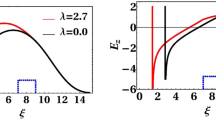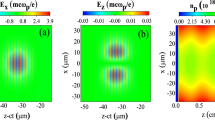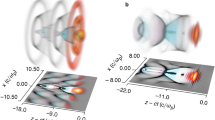Abstract
In laser-wakefield acceleration, an ultra-intense laser pulse is focused into an underdense plasma to accelerate electrons to relativistic velocities. In most cases, the pulses consist of multiple optical cycles and the interaction is well described in the framework of the ponderomotive force where only the envelope of the laser has to be considered. But when using single-cycle pulses, the ponderomotive approximation breaks down, and the actual waveform of the laser has to be taken into account. In this paper, we use near-single-cycle laser pulses to drive a laser-wakefield accelerator. We observe variations of the electron beam pointing on the order of 10 mrad in the polarization direction, as well as 30% variations of the beam charge, locked to the value of the controlled laser carrier-envelope phase, in both nitrogen and helium plasma. Those findings are explained through particle-in-cell simulations indicating that low-emittance, ultrashort electron bunches are periodically injected off-axis by the transversally oscillating bubble associated with the slipping carrier-envelope phase.










Similar content being viewed by others
Data availability
The data that support the findings of this study are available from the corresponding author upon reasonable request.
References
T. Tajima, J.M. Dawson, Laser electron accelerator. Phys. Rev. Lett. 43(4), 267–270 (1979). https://doi.org/10.1103/PhysRevLett.43.267
A.J. Gonsalves et al., Petawatt laser guiding and electron beam acceleration to 8 gev in a laser-heated capillary discharge waveguide. Phys. Rev. Lett. 122, 084801 (2019). https://doi.org/10.1103/PhysRevLett.122.084801
A. Rousse et al., Production of a keV X-ray beam from synchrotron radiation in relativistic laser-plasma interaction. Phys. Rev. Lett. 93(13), 135005 (2004). https://doi.org/10.1103/PhysRevLett.93.135005
K. Ta Phuoc et al., All-optical compton gamma-ray source. Nat. Photon. 6(5), 308–311 (2012). https://doi.org/10.1038/nphoton.2012.82
S. Chen et al., Mev-energy x rays from inverse compton scattering with laser-wakefield accelerated electrons. Phys. Rev. Lett. 110, 155003 (2013). https://doi.org/10.1103/PhysRevLett.110.155003
W. Wang et al., Free-electron lasing at 27 nanometres based on a laser wakefield accelerator. Nature 595(7868), 516–520 (2021). https://doi.org/10.1038/s41586-021-03678-x
P. Mora, T.M. Antonsen Jr., Kinetic modeling of intense, short laser pulses propagating in tenuous plasmas. Phys. Plasmas 4(1), 217–229 (1997). https://doi.org/10.1063/1.872134
D. Guénot, et al. Relativistic electron beams driven by kHz single-cycle light pulses. Nat. Photon. 11(5), 293–296 (2017). https://www.nature.com/articles/nphoton.2017.46. https://doi.org/10.1038/nphoton.2017.46
L. Rovige et al., Demonstration of stable long-term operation of a kilohertz laser-plasma accelerator. Phys. Rev. Accel. Beams 23, 093401 (2020). https://doi.org/10.1103/PhysRevAccelBeams.23.093401
F. Salehi, M. Le, L. Railing, M. Kolesik, H. Milchberg, Laser-accelerated, low-divergence 15-mev quasimonoenergetic electron bunches at 1 khz. Phys. Rev. X 11(2), 021055 (2021). https://doi.org/10.1103/PhysRevX.11.021055
Z.-H. He et al., Electron diffraction using ultrafast electron bunches from a laser-wakefield accelerator at khz repetition rate. Appl. Phys. Lett. 102(6), 064104 (2013). https://doi.org/10.1063/1.4792057
Z.-H. He et al., Capturing structural dynamics in crystalline silicon using chirped electrons from a laser wakefield accelerator. Sci. Rep. 6(1), 36224 (2016). https://doi.org/10.1038/srep36224
J. Faure et al., Concept of a laser-plasma-based electron source for sub-10-fs electron diffraction. Phys. Rev. Accel. Beams 19(2), 021302 (2016). https://doi.org/10.1103/PhysRevAccelBeams.19.021302
B. Hidding et al., Laser-plasma-based space radiation reproduction in the laboratory. Sci. Rep. 7(1), 42354 (2017). https://doi.org/10.1038/srep42354
O. Rigaud et al., Exploring ultrashort high-energy electron-induced damage in human carcinoma cells. Cell Death Dis. 1(9), e73–e73 (2010). https://doi.org/10.1038/cddis.2010.46
O. Lundh et al., Comparison of measured with calculated dose distribution from a 120-mev electron beam from a laser-plasma accelerator. Med. Phys. 39(6Part1), 3501–3508 (2012). https://doi.org/10.1118/1.4719962
M. Cavallone et al., Dosimetric characterisation and application to radiation biology of a khz laser-driven electron beam. Appl. Phys. B 127(4), 57 (2021). https://doi.org/10.1007/s00340-021-07610-z
T.L. Audet et al., Ultrashort, mev-scale laser-plasma positron source for positron annihilation lifetime spectroscopy. Phys. Rev. Accel. Beams 24, 073402 (2021). https://doi.org/10.1103/PhysRevAccelBeams.24.073402
E.N. Nerush, I.Y. Kostyukov, Carrier-envelope phase effects in plasma-based electron acceleration with few-cycle laser pulses. Phys. Rev. Lett. 103(3), 035001 (2009). https://doi.org/10.1103/PhysRevLett.103.035001
J. Faure et al., A review of recent progress on laser-plasma acceleration at kHz repetition rate. Plasma Phys. Control. Fusion 61(1), 014012 (2018). https://doi.org/10.1088/1361-6587/aae047
J. Huijts, I.A. Andriyash, L. Rovige, A. Vernier, J. Faure, Identifying observable carrier-envelope phase effects in laser wakefield acceleration with near-single-cycle pulses. Phys. Plasmas 28(4), 043101 (2021). https://doi.org/10.1063/5.0037925
S. Xu et al., Periodic self-injection of electrons in a few-cycle laser driven oscillating plasma wake. AIP Adv. 10(9), 095310 (2020). https://doi.org/10.1063/5.0014691
J. Kim, T. Wang, V. Khudik, G. Shvets, Subfemtosecond wakefield injector and accelerator based on an undulating plasma bubble controlled by a laser phase. Phys. Rev. Lett. 127, 164801 (2021). https://doi.org/10.1103/PhysRevLett.127.164801
J. Huijts et al., Waveform control of relativistic electron dynamics in laser-plasma acceleration. Phys. Rev. X 12, 011036 (2022). https://doi.org/10.1103/PhysRevX.12.011036
A.F. Lifschitz, V. Malka, Optical phase effects in electron wakefield acceleration using few-cycle laser pulses. New J. Phys. 14(5), 053045 (2012). https://doi.org/10.1088/1367-2630/14/5/053045
D. Guénot, et al. Relativistic electron beams driven by kHz single-cycle light pulses. Nat. Photon. 11(5), 293–296 (2017). http://www.nature.com/articles/nphoton.2017.46. https://doi.org/10.1038/nphoton.2017.46
F. Böhle et al., Compression of CEP-stable multi-mJ laser pulses down to 4fs in long hollow fibers. Laser Phys. Lett. 11(9), 095401 (2014). https://doi.org/10.1088/1612-2011/11/9/095401
M. Ouillé, et al. Relativistic-intensity near-single-cycle light waveforms at kHz repetition rate. Light. Sci. Appl. 9(1), 1–9 (2020). https://www.nature.com/articles/s41377-020-0280-5. https://doi.org/10.1038/s41377-020-0280-5
K. Schmid, L. Veisz, Supersonic gas jets for laser-plasma experiments. Rev. Sci. Instrum. 83(5), 053304 (2012). https://doi.org/10.1063/1.4719915
J. Primot, L. Sogno, Achromatic three-wave (or more) lateral shearing interferometer. JOSA A12(12), 2679–2685 (1995). http://opg.optica.org/josaa/abstract.cfm?URI=josaa-12-12-2679
J. Primot, N. Guérineau, Extended hartmann test based on the pseudoguiding property of a hartmann mask completed by a phase chessboard. Appl. Opt. 39(31), 5715–5720 (2000). http://opg.optica.org/ao/abstract.cfm?URI=ao-39-31-5715
M. Kakehata, et al. Single-shot measurement of carrier-envelope phase changes by spectral interferometry. Opt. Lett. 26(18), 1436–1438 (2001). URL http://opg.optica.org/ol/abstract.cfm?URI=ol-26-18-1436
F. Lücking, V. Crozatier, N. Forget, A. Assion, F. Krausz, Approaching the limits of carrier-envelope phase stability in a millijoule-class amplifier. Opt. Lett. 39(13), 3884–3887 (2014). URL http://opg.optica.org/ol/abstract.cfm?URI=ol-39-13-3884
R. Lehe, M. Kirchen, I.A. Andriyash, B.B. Godfrey, J.-L. Vay, A spectral, quasi-cylindrical and dispersion-free particle-in-cell algorithm. Comput. Phys. Commun. 203, 66–82 (2016). https://doi.org/10.1016/j.cpc.2016.02.007
M. Ammosov, N. Delone, V. Krainov, Tunnel ionization of complex atoms and of atomic ions in an alternating electromagnetic field. Sov. Phys. JETP (1986). https://doi.org/10.1117/12.938695
S. Bulanov, N. Naumova, F. Pegoraro, J. Sakai, Particle injection into the wave acceleration phase due to nonlinear wake wave breaking. Phys. Rev. E 58(5), R5257–R5260 (1998). https://doi.org/10.1103/PhysRevE.58.R5257
P. Tomassini et al., Production of high-quality electron beams in numerical experiments of laser wakefield acceleration with longitudinal wave breaking. Phys. Rev. ST Accel. Beams 6, 121301 (2003). https://doi.org/10.1103/PhysRevSTAB.6.121301
B. Beaurepaire, A. Lifschitz, J. Faure, Electron acceleration in sub-relativistic wakefields driven by few-cycle laser pulses. New J. Phys. 16(2), 023023 (2014). https://doi.org/10.1088/1367-2630/16/2/023023
J. Kim, T. Wang, V. Khudik, G. Shvets, Polarization control of electron injection and acceleration in the plasma by a self steepening laser pulse (2021). https://doi.org/10.48550/ARXIV.2111.03014
R. Rakowski, et al. Transverse oscillating bubble enhanced laser-driven betatron x-ray radiation generation (2022). arXiv:2202.01321
Acknowledgements
This work was funded by the Agence Nationale de la Recherche under Contract no. ANR-20-CE92-0043-01. Numerical simulations were performed using HPC resources from GENCI-TGCC (Grand Équipement National de Calcul Intensif) (Grant no. 2020-A0090510062) with the IRENE supercomputer. This project has also received funding from the European Union’s Horizon 2020 Research and Innovation program IFAST under Grant Agreement no. 101004730.
Author information
Authors and Affiliations
Corresponding author
Ethics declarations
Conflict of interest
The authors declare no competing interests.
Additional information
Ultrafast Phenomena from attosecond to picosecond timescales: theory and experiments. Guest editors: Franck Lépine, Lionel Poisson.
Appendix 1: PIC simulation results for an initial CEP of \(\pi /2\)
Appendix 1: PIC simulation results for an initial CEP of \(\pi /2\)
Figure 11 shows a similar PIC simulation analysis as in Fig. 6 of the main text, but with an initial CEP shifted by \(\pi /2\). There are again clearly three main injection events, yielding three separate micro-bunches, but now electron are mainly injected from the top (blue) with a negative initial momentum and the total beam points downward at the end of the simulation.
Particle-in-cell simulation of a LPA driven by a 4.0 fs laser in a helium plasma, for an initial CEP of \(\pi /2\). a Snapshot of the wakefield, showing three different injected sub-bunches. Electron density in the (y, z)-plane is shown in gray, and injected electrons are displayed in orange (blue) when their pointing is positive (negative) at the end of the simulation. The normalized laser electric field \(E_l/E_0=E_l/(m_{\text {e}}c\omega _0/e)\) (red dashed line) and its envelope (blue solid line) are also shown. b Top: transverse momentum in the polarization direction as a function of propagation distance for two sub-bunches injected with a positive (bunch +) and negative (bunch −) initial transverse momentum, corresponding to opposite signs of CEP-dependent bubble asymmetry at the moment of injection. Bottom: longitudinal momentum of the two sub-bunches. Both momenta are normalized to \({m}_{\mathrm{ec}}\). c Asymmetry of the wakefield in the y-direction (red) and difference in the mean position of the bubble in z between the top part (y > 0) and the bottom part (y < 0) of the wake (black). Charge injection rate for the two electron populations shown in a with corresponding colors, as a function of the simulation time for an initial CEP of \(\pi /2\). The gray dashed lines highlight the three main injection events
Rights and permissions
Springer Nature or its licensor (e.g. a society or other partner) holds exclusive rights to this article under a publishing agreement with the author(s) or other rightsholder(s); author self-archiving of the accepted manuscript version of this article is solely governed by the terms of such publishing agreement and applicable law.
About this article
Cite this article
Rovige, L., Monzac, J., Huijts, J. et al. Carrier-envelope phase controlled dynamics of relativistic electron beams in a laser-wakefield accelerator. Eur. Phys. J. Spec. Top. 232, 2265–2276 (2023). https://doi.org/10.1140/epjs/s11734-022-00675-7
Received:
Accepted:
Published:
Issue Date:
DOI: https://doi.org/10.1140/epjs/s11734-022-00675-7





